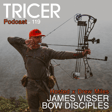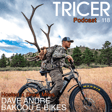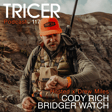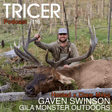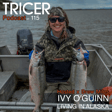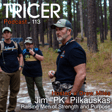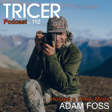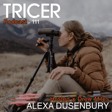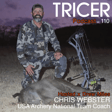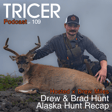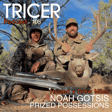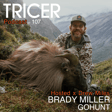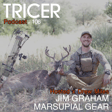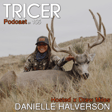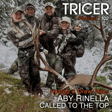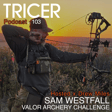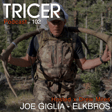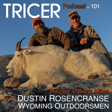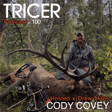Become a Creator today!Start creating today - Share your story with the world!
Start for free
00:00:00
00:00:01

How To Hunt Coues Deer – Jay Scott
This week Drew has Jay Scott on the Tricer Podcast to talk about hunting the elusive coues deer. Over the years Jay has become known as a coues deer expert and on this show he displays why. Jay talks about his experience hunting and glassing for coues deer. Jay and Drew also discuss the importance of a tripod and how using one changed the glassing game. Jay talks a lot about tactics for hunt coues and in the end he explains why he loves coues deer so much.
JAY SCOTT
Instagram - https://www.instagram.com/jayscottoutdoors/
Website - http://jayscottoutdoorspodcast.com
TRICER USA
Website – https://tricerusa.com/
Instagram - https://www.instagram.com/tricerusa/
Facebook - https://www.facebook.com/tricerusa/
YouTube - https://www.youtube.com/@tricer6985
Transcript
Introduction and Prayer
00:00:01
Speaker
You are listening to the Tricer Podcast, where we talk all things hunting, gear, and the great outdoors. Before we begin, let's start things out right and put God first. Lord Jesus, I thank you for Tricer, and I ask that you can use this podcast as a way to bring joy to all of our listeners. We lay Tricer and this podcast at your feet. Amen.
J. Scott's Influence
00:00:22
Speaker
So I would have to say, if you asked me which person in the hunting industry I have the most respect for, it would probably be J. Scott.
00:00:31
Speaker
And I've had the privilege. You're just saying that because I'm on the other line, Drew. I've had the privilege to get to know Jay over the last couple of years and just have lunch with him and talk to him a lot. And it has to be one of the most genuine people I've ever met and the kindest people in the industry, hands down. So Jay, how you doing? I'm doing good, but it's my head's about to explode with that introduction. So Jay, did you know that, um, so my first out of state hunt was a javelina hunt in 20,
00:01:00
Speaker
15 or 16, and I had no idea what I was doing. I had a pair of like ah Redfield binoculars on my chest, no tripod whatsoever, and I went over to Arizona, and my buddy's like, he had gotten a tripod somewhere, and he's we end up listening to a J. Scott podcast on the way home. and so Without you knowing it, you taught me how to hunt.
00:01:23
Speaker
Well, i I don't know what to say about that, but I'm glad at least to get one or two listeners out of all these years. I'm grateful for that. And um obviously, you know,
00:01:36
Speaker
building that fire inside of you that's you know made you create just an incredible company with Tricer and what you've got going is is really cool to hear you say that. And I'm excited to hear that I was a little part in in you know kind of kindling that fire inside you to to to want to glass better and be better.
00:01:57
Speaker
Uh, be
Educating Hunters with Podcasts
00:01:58
Speaker
a better hunter. And, you know, for years with my podcast, what I try, try to do for a long time is just educate and inform people. And, um, you know, with my interviews, try and pull out the best I could have people so that everyone listening could get a little nugget, um, and, and maybe be able to take that into the field to make them better at what they do more efficient at what they do. And so.
00:02:23
Speaker
You know, kind of my personality, I tend to analyze and some would argue, my wife would probably argue over analyze and and try and be efficient with a lot of things that I do. and So, you know, with my podcast, um, you know, my stylist is, you know, I've heard it before somewhat dry and whatnot. It's not too entertaining, but I feel like there's a lot of information and education. And, you know, over the years I've, I've, uh, been able to help people be better. And, you know, for me, um, the whole reason I started my podcast was just to help people be better at what they do and and help them learn something. So.
00:03:03
Speaker
you know to to have you say in 15 or 16, you listen to a podcast and now to see where you've gone and and what you've done with with ah your hunts and with your company. um you know i Again, I'm just ah proud to play a small part in that. Yeah. and you know I know people outside of Arizona, I would say Southern California, but arizona Southern Southwest aren't going to like this, but the best glasses in the world come out of Arizona.
00:03:33
Speaker
and glassing pretty much originated in Arizona because of our favorite deer, the coozed deer, which I have a love for, probably because listen to your podcast, honestly. And it's been really neat to kind of meet like some of the royalty, right? Like I got to be become really good friends with Cody Nelson as well, who's a good friend of yours. And I'd love to start picking your brain on that a little bit.
Evolution of Glassing Techniques
00:03:53
Speaker
Let's start let's talk start about that. Like let's talk about tripods and where, you know, where you were at in the nineties compared to where you are now with glassing and and where how that evolved.
00:04:01
Speaker
Yeah, you know um i I don't know if I completely agree with you saying the best glossers come out of Arizona, but I would certainly agree. you know Um, glassing here in the Southwest, you know, Arizona, New Mexico, Utah, Colorado, but you know, there's something to be said about the coosier hunters. Um, the guys that were, you know, paving the way before us and before me and before you, um, that figured out that these coosier are very difficult to spot. And as you know, um, you know, it still happens to me to this day where, you know, you're looking at a deer, you've spotted them. He's, you know, 750 yards away and.
00:04:40
Speaker
on an open hillside and you know you're looking through your binos on a tripod you're stable everything's good you look over to the side maybe to get something out of your pack you go right back in your binos and you can't see the deer and the deer hasn't moved and then all of a sudden that ear flicks and you realize the deer is right centered in your binos he never moved and There's not a lot of other animals I feel like that that happens with. um but you know With the way the coosdeer blend into their terrain, I think it's forced guys that hunt for coosdeer
00:05:18
Speaker
extensively and and have kind of cut their teeth on coos to become very, very good, efficient glassers and be very detail-oriented and you know learn the speed of glassing and the pace of glassing. um and And quite honestly, you know if if we were routinely looking at bigger animals um that that didn't blend in as well. I don't think you know some of us guys in Arizona that have you know grown up cooster glassing would be as good as as as some of the guys are. ah you know I think the animal itself lends themselves to ah you know kind of making maniacs and free glassers in that
00:06:01
Speaker
just like that example of that deer that's centered in your binos. And sometimes you look back and you you know you can't even see where the deer is until it moves, flicks a tail or or you know twitches his head or something.
00:06:13
Speaker
ah you know there's There's a lot of guys in front of me. you know I remember buying my first pair of Swarovski 10x42 SLC binoculars. I had kind of graduated from the 10x40 Zeiss, the black ones. i I didn't have a tripod or have them mounted on a tripod.
00:06:32
Speaker
And I remember Darren, I actually scrimped up and and saved and we each got a pair of 10 by 42 SLCs. And um then then you know quickly mounted them on a tripod and you know the tripods were cheap and um had like the la the ah Velcro strap. and you know But once once we had the ability to mount on a on ah tripod,
00:06:58
Speaker
For me, it kind of changed the way I
Strategies for Effective Glassing
00:07:01
Speaker
hunted. It changed the way I glass. It changed the way I looked at these deer. It changed my whole outlook. It changed the whole system that I use. um and and you know Quite honestly, i I think I was a pretty darn good glasser off my knees ah with those Ice 10x40s.
00:07:22
Speaker
Once I was able to mount those on a tripod, um even though the adapter at the time with the Velcro strap on both sides wasn't super efficient, um it took glassing to a whole other level for Dara and I um and and even Cody Nelson. At that time, you know Cody was um Probably right about the same time he bought those 1560s ice the big size the big hammers and um He was mounting those and you know Dwayne Adams um You know just awesome Dwayne Adams down in southern Arizona kind of you know one of one of what I would call the godfathers of of you know glassing and cooster hunting and Someone I look up to to this day ah very much Yeah, I listen to a podcast with Dwayne that with you. yeah He said the angle the dangle and that changed my life Yeah, and you know we can talk about the angle the dangle that the interesting thing is you know once you glass on a tripod and you have a system which is um You know what darn I learned early on and Cody learned early on and
00:08:31
Speaker
through trial and error mainly, um but once you got that angle where you could get on a lip of somewhere where you have a big broad view, you know, and you could see down, you could see across, you could see up, um and then start using the contour, you know, whether it's, whether it's you know, just a saddle of a ridge, a rock pile, something that gets you up where you can see,
00:08:58
Speaker
Um, you know, I think, I think being able to have this open terrain that we have here in Arizona and Mexico, I think, you know, anybody listening that, you know, maybe not as familiar with glassing off a tripod, you know, but they're from Michigan and they can only see, you know, 200 yards. I get it.
00:09:16
Speaker
But once they come out and hunt with us and once they spend some time out in this open country, um I think people get better quickly once they realize there's some of those little tricks um of of finding good glassing areas, good glassing spots, what makes a good glassing spot, etc.
00:09:35
Speaker
um And once you once you put yourself in that type of position, then it just becomes a matter of slowing down and and sometimes speeding up ah depending on on what you're doing, but getting kind of a system. And then as you, for me, um I got more and more confidence ah as I became began to glass off of a tripod and, you know, glassing with Dar and, and and you know, he's still probably the best glasser I've ever been around. Um, his son's pretty darn good as well. But you know, we had young eyes then, you know, I'm 51 now and you know, I was probably
00:10:17
Speaker
25 years ago or so, but, um, you know, you get to learn a system once you implement that system, and then you get a little bit of confidence. Um, I think that's what makes good glassers is, you know, once they become confident in their ability to be able to go anywhere. Um, you know, and kustere glassing has kind of taught me to, I feel like I could be dropped off anywhere in the world. And, and, and, you know, with the tripod and a good pair of binos,
00:10:45
Speaker
If I can see any distance at all, I feel like I'm going to be pretty efficient at finding game for sure. Yeah. People don't really believe me, but like i I say all the time. For one, I would give up all my weapons just to glass the rest of my life, if I had to pick between the two. and I will glass, no joke, eight to 10 hours a day. like like Once you figured out, like you like when I first started hunting, I was doing so much more hiking.
00:11:12
Speaker
And now I've just learned like find good knobs and you could glass, you could almost gloss from one spot and some places in Arizona, you can last from one spot all day long and pick up gear all day long. Yeah. I i think too, Drew, like when you can mix the ability to really hike and and cover country and get to knobs early, you know, get there in the dark, be able to cover it for two hours, hike up to another knob, glass it for another couple hours.
00:11:37
Speaker
when you mix, you know, some of the best glasses I know, um, still cover quite a bit of country with their legs and, and, and, you know, there's, there's great glasses that, that, you know, don't cover as much country with their legs, but cover it with their eyes. But if you can mix the two where you're covering with your legs and your eyes, um, I feel like, you know, that's getting you into ridges in country that maybe everyone isn't looking at. Um, you know, and I think that's where sometimes the size of,
00:12:06
Speaker
of your animal and maybe some of the numbers of your animals go up ah for sure. That's one of my favorites I have to do, especially in Arizona, is you know get in like a mile, get in there at least a half hour before were dark ah before sunrise, glass for you know that first that first hour you want to be in that spot. And then, especially if you're at Ridgeline, where you can actually kind of work at Ridgeline throughout the day and just keep moving up. And it doesn't have to be that far. It could be a quarter mile. You'll see a totally different country just by moving. that's that When I said angle to dangle earlier, that's Duane's point. Sometimes you can move 20 yards and see a totally different perspective of a valley or something across from you.
00:12:40
Speaker
So yeah, if you can be mobile, I totally agree. Yeah. And and with that, you know, ridge lines are all always great to be glassing off no matter what you're hunting, because with very little movement, you can change what you're looking at. You know, you can move over 10 yards, 15 yards, 20 yards, 50 yards, and completely change the angle of you know direction. You can be looking south and you can be looking north.
00:13:05
Speaker
and you know with with walking 5 or 10 yards. ah you know So I love big you know isolated glassing peaks where you can you know spend 360 and be looking in every direction. I love ridge lines, um and especially where they have little bumps in them where you know you can gain elevation and then you you know cover country um For sure and you know, I think Arizona lends itself ah with the terrain and vegetation um And where you like Dwayne says that angle of the dangle where you know, you want to get to where you can see You know down and and get that you know Get that angle where you know, you've got a rock pile or something that gets you out where you can see down across and and everything if if you're on a level flat
00:13:57
Speaker
um plane, you pretty much can just see what's in front of you. I like to get out on those corners of those ridges and whatnot, where you kind of be able to see left and right in a good distance, you know and ah a wide ah degree of angle there, and then also see down and also see up. So that's that's a huge thing.
00:14:17
Speaker
I feel like you always want to have your feet below you. I think that's a good kind of motto for that. If you can find a spot where your feet are below you, you can glass across. I never want to be at the bottom of a canyon looking up, especially for Coos Deer. I mean, an elk besides the school bus, but at Coos Deer, it'll kind of joy a cat because you can't see it. If you're looking up at them, you want to be up high and looking across.
00:14:38
Speaker
You can look down and across. The thing about down and across that angle um is with the vegetation, you know, here in Arizona and Mexico where the Q-steer really like to live.
00:14:50
Speaker
If you can be looking down and across, in other words, it takes the play of that vegetation that's, you know, two, three, four feet high, and where you're just looking at the top of their back. If you're up looking down, you open up that whole angle of being able to now see from like their knees up. And so, you know, typically looking up for coost here, it's very difficult because they're not very tall animals.
00:15:15
Speaker
and that vegetation gets to sometimes where you can only see their rack or their ears. Whereas if you're looking at level um or down, um it it it opens up that whole plane um and and gives you a much bigger ah angle there to to see their body.
00:15:34
Speaker
Yeah, I kind of drove some of my camera guys crazy this year because I have a thing. It's very similar to me for like coyote hunting. Like if I go into a coyote stand and it doesn't have the right wind or I don't have the right elevation, I don't want to hunt it. I'd rather just move on to waste my time. And the same thing for glassing. I'll take the extra 15 minutes to go the next quarter mile to get to a good point. And actually, when we killed my son's, my his bigger buck this year in Utah, we were only going to move like a quarter mile and we ended up going. When I got over there, just didn't look right. we ended up going like another half mile to get to a point where I actually could glass up and across and see these canyons. um Like I think it's worth the time to get to a point where you have a good glassing knob. It's just you're going to gain more from it than trying to glass uphill.
00:16:15
Speaker
Yeah. And you know, another thing, um, taking so many hunters over the years and, and having a lot of different, uh, variety of people with different, um, levels of skill and whatnot. I think a lot of it too is, is your approach to those glassing spots. And you know, you can have the greatest glassing spot.
00:16:36
Speaker
there is out on a rock pile out on the tip of a ridge. But if by the time you get out there and get all set up, you know, that, that big old goose buck that's laying over there at 450 yards has watched you the whole time. He's either going to stay there and lay low or he's going to have already squirted out of there. So I think, you know, a tip that I could give to guys out there is, you know, find those great glassing points, you know, in your research, whether you're, you know, whatever mapping system you're using, go hunt maps or,
00:17:05
Speaker
or Google Earth or whatnot. But, you know, try and figure out your ingress and egress, how to get in and out of those glassing knobs and spots um and without being detected and without being seen. And, you know, there're there's guys that really like glassing off stools and and all of that. I kind of prefer I'm a little old school and kind of like glassing off my rear end. But um part of that is to get as low as I can um and and stay as low as I can. So my profile you know, isn't up. and And, you know, there's a lot of things that I like about your tripods, but one of them is that they're quiet. And, you know, there's nothing that irritates me more than when we've snuck, you know, we've hiked our, our butt off all morning to, you know, hiked in an hour with headlamps and get almost to where our glassing point is, and then
00:17:59
Speaker
you know I said, okay, let's sneak out here. And we just slip out to the edge of that point. And there's beautiful canyons on all sides of us and get out there and guys start clanking their you know aluminum tripod legs together and and you know making noise.
00:18:16
Speaker
um you know that that's That's one thing as a guide and outfitter, ah you know being stealthy, I always say, you know approach every glassing point as if um you're you're in a you're in a war. someone you know That deer that you're trying to find is going to shoot back at you. and If you kind of approach it like that, where you know like it's literally wartime and that those animals could shoot back at you, you would probably do things differently. and Once I started kind of thinking about it like that, I chose my knobs differently. I chose how I approach those knobs.
00:18:53
Speaker
and i approached how i sat there and and glass because you know I've seen some of the biggest bucks we've ever shot you know have been because we were able to sneak in and not be detected ah by them. Whereas I've seen some great bucks get away because of errors that I've made or errors that you know people with us have made. um and And it's just something trial and error that I've learned to to be very stealthy when you get up there and be you know glassing on those knobs and whatnot.
00:19:26
Speaker
Yeah, I've blown quite a few deer out, just skylining myself and it's coming up. A lot of times it's because it's the middle of the day and you're not thinking about it and you're just going along and doing it. You get up there and all of a sudden you freaking blow out. A lot of times those coups of deer, there's more than one, right? Or you'll get a doe and she'll blow out and take all the bucks with them.
00:19:46
Speaker
it's just a You got to be careful with that 100% and they are, I mean, they are the most weary deer. We're going to get into that too, because I want to talk about ah why it's the greatest deer God ever made.
Application Across Terrains
00:19:55
Speaker
But I'm going to do glassing a little bit more before we get to that point.
00:20:00
Speaker
um Glassing kuzia, I feel like I find a lot of deer in the morning. I feel like I kill the majority of my deer between like 10 and 2, or majority of my deer between 10 and 2. So many guys go back to the truck.
00:20:16
Speaker
I love that time of day because it's like the rebedding time and I feel like they're a little bit more like does they get up for that 15 minutes? And I feel like you could find a lot of gear in that timeframe. You know, probably 25 years or more ago, Dara and I were in unit 34A in Arizona in January and it was archery season. And, um, maybe this was 30 years ago now, but a long time ago, um, we ran into a game, uh,
00:20:45
Speaker
He's retired now, a retired game and fish officer. His name's Kurt Batty. I think it's B A H T I. Um, and he was kind of a legendary game and fish guy and, and, and an avid coos deer hunter. And we ran into him in 34 a and we had seen quite a few deer and, you know, we were kind of just talking to him. He was talking to us and I forget if he checked our licenses or what, or maybe he was hunting. I don't remember exactly, but, um,
00:21:16
Speaker
Regardless, um we we were talking to him and he said, you know, boys, he said. ah He said, you've seen quite a few deer. I said, yeah, we've seen quite a few deer. He said, you know, um, I highly recommend that you spend a lot of time between 10 and two glassing. And you know, at the time I was like 10 and two. And he said, yeah, he said, you know, that shade change. He said, when that shade changes, those deer will get up. And a lot of times they'll get up and and feed for a little bit. They'll get up and change their angle, uh, their position where they're, where they're bedded.
00:21:51
Speaker
They'll, they'll feed a little bit. Maybe they'll go to the bathroom and then they'll lay back down. And he said, you guys need to be glassing between that 10 and two. And, you know, Darren, I had done a little bit of it, but I, I credit Kurt Batty for, for telling us, you know, these Cousteers specifically, uh, most always will get up between 10 and two. And, and from that day on, Darren, I really started glassing, uh, you know, heavy in the morning at prime, what I call prime time. And then.
00:22:20
Speaker
If you got to take a little break or move to another knob or, you know, even go back to camp, go to the truck or whatever you need to do. But then we started really glassing between 10 and 2. And with that, he also said, you know,
00:22:35
Speaker
pick out ah on those hillsides, pick out the most predominant afternoon shade spots. And that really resonated with me. And so once we kind of honed in on throughout the year, 365 days a year, if you look at a mountain range, if you you can look on a map or you can just go and say, where is the predominant afternoon shade?
00:23:01
Speaker
So on that hillside, where does that afternoon shade fall every day, day in and day out? Where does the shade hit first? Where does the shade stay the longest? That's where we started finding the most deer, the more mature deer No matter what time of year, it really holds true in the non rut times when, you know, it's really warm out. And, you know, in the summer and in the fall, when a lot of those early cooster hunts are going on.
00:23:33
Speaker
If you really just get to where you're glassing those afternoon predominant shade pockets, um you know our buck numbers went up, our our maturity of bucks went up, our total deer sightings went up, but that also coincides with the 10 and 2. The 10 and 2 is you know, with that sun coming up ah in the east, with the shining, you know, if you're glassing west, and then as the sun progresses in the afternoon, then all of a sudden that same slope, you know, turns into that shaded slope. The sun's on at first, but then it becomes the shaded slope.
00:24:10
Speaker
those deer would bed down a lot of times, you know, seven, 30, eight, nine, 10, you know, nine o'clock in the morning. And all of a sudden that sun has kind of moved its angle. So now it's, you know, it was down here and now it's up here. And now the place where they were laying is now in the sun and they've been laying in the shade. And hence the 10 to two,
00:24:35
Speaker
When that sun is at it and its pinnacle at at noon, it's straight above, but then as it turns you know one to a clock, now that deer that was in the shade is now in the sun, so that's what makes them get up, feed for a second, stand there for a minute, move around, and then rebed.
00:24:55
Speaker
um and And so you know I credit Kurt Batty, Dwayne Adams, ah you know you know those two guys ah with a lot of things that I've learned for glassing for coups and then you know just basic trial and error. and And it's amazing though, once you kind of grasp those concepts of Deer are no different than if you were to lay out there all day and it's warm, you're going to seek the shade. So you know if you can learn to you know glass in those in those shaded pockets, you're going to find more mature deer, you're going to find more deer. you know and it It translates to elk, it translates to mule deer, it translates to bighorn sheep.
00:25:41
Speaker
um And and it's it's really common sense if you think about it with, you know, the the cooler areas of the mountain that are out of the shade. Well, you know, every day of the summer, they're going to seek those areas that they can get the most relief from. Yeah, and you can feel it when you're hiking around out there too. Sometimes you'll be hiking, and you'll drop down into a canyon and like northeast facing, you're like, wow, it is, notice will be cooler here.
00:26:07
Speaker
That's what you need to be looking for with your binoculars, sun in your face. You're almost always cooking when you're glassing them. But that you can just tell like, oh, wow, this is noticeably cooler. And it and ah it does transcend into everything else, into elk, into mule deer, sheep, whatever you're glassing. Because they have a fur coat on, right? You're hot and you're stripping down to your base layers. They don't get to strip down to middle of the day. They have to find shade.
00:26:31
Speaker
And I think that's where like the tripod really comes into play, right? Because you said, like look for those shaded spots. And with Koo's deer, and that's why I love them so much, I think the 15s are the greatest binocular ever made, that the SLC 15s, right? I think that the 14s of this come out, I've got to get a pair. But like you get a pair of 15s on a tripod, and you look at the same bush for three hours, and then all of a sudden, you see an ear flick.
00:26:57
Speaker
yeah And there's a deer there. And that's where the ah tripod is so important. Well, and I think too, where the tripod's important as well is you make a good point. So if you're looking into the shade in those afternoon settings, you're getting a lot of glare. And if you've ever tried to handhold binoculars looking into a glare, it's very difficult. But if you can have them on a tripod and have them very steady,
00:27:25
Speaker
It's much easier to look through the glare when the but binoculars are stabilized on the tripod. You know, a couple of things you said there. ah Deer can absolutely be on south facing slopes. Deer can absolutely be on west facing slopes. Big bucks can be on south facing slopes. Big bucks can be on west facing slopes. I don't want anyone to think, and and I get it on my Instagram some saying, oh, I found a big buck. You can find them anywhere.
00:27:54
Speaker
But when I'm talking about glassing predominant shade areas, I'm talking about majority of mature deer, mature majority of deer. But a deer can literally be anywhere. So anybody listening, don't don't don't not glass those west facing slopes. Don't not glass those south facing slopes.
00:28:13
Speaker
One of the things that you do when you're looking at an open south facing slope or a west facing slope is ask yourself, okay, if I was a deer on this sun exposed hillside, yeah we've walked across south facing and west facing slopes and seen all kinds of sign.
00:28:32
Speaker
we know that they go there. If I was going to go there, where is the shady spot? It may be a tree, it may be ah ah an ocotillo grove where it's thick ocotillos that you don't think provide much shade, but there's plenty of shade there. And then they just kind of move around that ocotillo as the day progresses. um So just to be clear with your listeners, like You know, I'm a proponent of glassing north, northeast, east facing slopes a lot. But I also look at the other slopes, but when I'm looking at those south and west facing slopes, I'm really looking, okay, scan the open, but okay.
00:29:13
Speaker
It almost pigeonholes those deer into even more specific spots because they're not going to be out in the middle of the day in that wide open stuff. But where is a little fold? Where is a little crease? Where is there, you know, a stand of oaks or manzanita?
00:29:30
Speaker
where a little deer, all they have to do is, I mean, I've seen them with one saguaro basically move around all day as the shade changes and theyre they there's one mesquite tree and there's four deer moving around the only shade on the hill.
00:29:46
Speaker
But what it allows you to do is be more efficient when you're looking and going, okay, I don't see them in the open. Where's the most obvious spot on this hillside where there's some shade where deer are going to be? And boom, you pick them up. The benefits of a tripod are you can kind of really peer in and and and and you know look for that black eye. You can look for that tail flick. You can look for an ear where You know, if deer are up feeding, and especially guys with young eyes can just handhold and spot deer like crazy. They glow. In the morning and they glow. Yeah, they glow. We're using a tripod, and that's why I'm such a big believer in tripod glassing, is
00:30:33
Speaker
when it's not easy and when you've got to slow down and when you've got to you know look for those bedded deer, you've got to look in those shaded pockets where you've got glare and and different things. so um That's where you know glassing off of a tripod for me has has found it found its value.
00:30:51
Speaker
Yeah, and I think it's important to note too, like in the morning, let's say the first couple hours of the morning, gloves are kind of off. You're you're looking around, there's going to be deer a lot more places. But when you, like, if you want to be like a very successful deer hunter, I think you need to glass all day long. And it's a numbers game at that point. Well, I'm not going to be looking at this 90 degree hillside when I know it's maybe 75 degrees over in the shade over here. So I want to put my money on, you know, the high, the high,
00:31:19
Speaker
Probability areas high probability areas and that's where you want to be, you know looking into that shade stuff, right? But yeah in the mornings, man They're kind of you know, sometimes you're gonna move in and they are kind of in a certain area, you know They don't really go too far But yeah, you get them on their feet middle the middle and they do glow man, especially first thing in the morning You got those deer up there. They're glowing. There's six does around a buck over here, you know, but then all of a sudden they disappear and We should let's keep going on the tripods, but yeah good. I think I think the The velocity of glassing also is, you know, the speed of glassing can be beneficial with tripod.
Tricer Tripod Innovations
00:31:55
Speaker
um you can you You can glass very quickly off of a tripod. And I would argue just as quick as you could if you're free handing. But the thing that you have with the tripod is the efficiency. if efficient So you can speed glass. Dar is amazing when
00:32:13
Speaker
You know, I've watched him at first light and I mean, he's just literally shotgun and he's just moving that tripod handle around and he is just looking and from spot to spot to spot, to spot up down. He's just, he's not gritting. He's, he's literally for the first 30 minutes, he's just looking here, looking there and you know, he sees a deer. Okay. Now he's going to focus in and okay. What's around. Okay. There's one deer. What's here. What's there.
00:32:40
Speaker
and and And so you know that's where glassing off of a tripod is with a good adapter where those binos are stable, where you're moving those binos very quickly, that's where glassing off of a tripod is also very beneficial. So I mean, I look at it as you know speed glassing, very efficient glassing when you're moving, but then I also look at it as the day as the day wears on, then slowing down and starting to look into those pockets where those deer are bedded, where those deer are stationary.
00:33:13
Speaker
um you know the the The other thing is like standing or sitting. um you know You make tripods that you can stand behind. You make tripods that you can sit behind. You make tripods that you can do both. um you know and I feel like I'm a big proponent of, especially in you know when you're really after something hard, is try and get as low to the ground as you can.
00:33:40
Speaker
um and and try and get those tripod legs ah out where they're good and sturdy, stable. Try not to use the extension as um as as much as possible. in In other words, try and make everything that you're doing as efficient as possible. um And and you know getting low to the ground some guys like glassing off of a stool because it's more comfortable and and and I would say whatever makes it more comfortable for you, whatever allows you to stay in the glass longer is better. If it's sitting on the ground, great. If it's glassing off of a stool, great. If it's standing, great. you knowve I've caught some flack over the years for for being picky of guys standing and glassing and it's
00:34:23
Speaker
It's not that I don't stand in glass at all because I do, but hunters that come and hunt with us over the years, when I see them right off the bat standing and glassing, and and some of these are, you know, 25, 30 year old guys that don't have bad backs and, you know, they're just standing and glassing. For one, you're a target. They can see you, you know, you're standing out. um And I believe you know, standing has its its time and its place. Sometimes you want to stretch and just stand in glass. That's better than, you know, getting out of the glass.
00:34:55
Speaker
um But you know I don't know where I got off on this tangent, but I like sitting and glassing best. um But I do like the fact that you've created these tripods where you can sit and you can stand. And you can be pretty darn efficient standing as well. And you know as as I've gotten older, I get to where I do extend the legs and stand up for a while in glass and glass.
00:35:20
Speaker
then go back down and sit and stand back up and kind of move around, get the blood flowing a little bit. um and And that's you know another benefit of having a tripod is you you can do both, but you want to have that stabilization. It's very important to to to make sure that those binoculars um are stable um because any vibration that you're gonna get, are going you're gonna miss stuff. And especially the older I notice, the older I get, the older my eyes get, um they're not as sharp as they once were. And so I have to be even more stable um every every year that goes by that I get older, I have to be more stable.
00:36:01
Speaker
man, I'm just now experiencing it. Me and my wife, we make coffee and read the Bible together every morning. We do this year Bible, and we have cheaters now. You put them on, it feels so good. What number of cheaters are you? The 1.25? That's the lowest power. No, I think I got like- One and a half?
00:36:20
Speaker
or something like that. It's too much to work. If I look far away, it's blurry. But you put them on, it's like, oh, that feels so good. It's so good. But I'm actually running eye drops now because my eyes, when I bring eye drops in my vinyl harness, my eyes just trying out in the arc and a little bit worse out there. So my setup when I'm glassing,
00:36:39
Speaker
pretty much exclusively is I'm always going to take my back two legs and I'm going to put those in the second position, which is kind of like a 45 position and the front legs pretty much going to be straight down. And I always extend on my tripod since they're inverted, I always extend the fat legs first. I never extend the skinny legs. So like if you're going to be, say you're using a traditional tripod, you always want to extend the thickest legs first, not the skinny ones because the skinnier you go, the more flex you're going to get in there. Right. So I want to have those back two legs and a 45 wrapped around my body.
00:37:07
Speaker
And then I want to be into that tripod. And a lot of times I actually have my weight on the tripod and I'm glassing. um ah you You're a little more stable. That's one of the things that first brought me to your tripods is when I saw your inverted legs. um As someone, you know, used a bunch of different tripods. um But once I saw your inverted legs, to me,
00:37:30
Speaker
That kind of gave me the sign that you either knew the value of of having your thickest legs do the most work for you or that you wanted in other words I wasn't sure if you knew or if you were just thinking that that was a good idea but after getting to meet you I realized that you understood that having those thicker legs be the ones that do the most work for you the most of the time is important whereas if and I'm sure people listening if I'm sure they've seen your tripods but um you know the the principle is basically um on
00:38:15
Speaker
other tripods that aren't like Tricer, you see guys using the skinny leg portion a lot where I would try and use that as a last resort. I'm going to use basically just the the the standard tripod, not extend the little skinny parts if I don't have to. Well,
00:38:38
Speaker
When I saw these Tricer tripods with the inverted legs, I thought either Drew's been listening to my podcast and I didn't know at the time. Which I had been, yes. He's either listening or this guy knows something that I had already figured out and that Cody and I had already been talking about. So that was the first thing when I saw Tricer tripods, I'm like, this guy wants, he either knows it or he's just learning it and he wants to make a stable tripod. And so that's that's the first thing I saw with Tricer that kind of got my attention.
00:39:15
Speaker
So one of the things that I've been really good at is just listening, right listening to you, listening to Cody, listening to Brady, listening to podcasts, and listening to complaints. And then it's addressing those complaints. It's basically making a better mousetrap, right? So hearing these things, right? And how can I make this a better product? um you know How can I how could i have the stability of an aluminum tripod with a carbon fiber tripod which puts weights in the leg, right? And then we're just trying different things, right? And then there's some stuff coming out this year that's just going to blow people's minds with the hexagon legs and stuff.
00:39:45
Speaker
Well, the thing that after then I learned a little bit about those inverted legs, um we ended up, you and I had some conversations on, I believe, Instagram chat or something, and then I wanted to meet you in person. Then we had a couple of lunches where we've kind of talked in depth about things. and the The biggest thing that drew me to you was in my opinion, there's no one else out there making hunting tripods. That's a hunter like you are. And that's willing. I mean, I mentioned something. Hey, you should try this. Well, you went home that night and mocked up a or mocked up a.
00:40:24
Speaker
a prototype and we're like, Hey, what do you think of this? The next morning you sent me a design. I was like, I can get behind this because here we've got a guy that is identifying a problem. And overnight you're drawing up this, you know, you've got that engineering mind, that machinist mind, and you're, you're mocking up, um,
00:40:48
Speaker
something we had talked about and i wanna say within like a day you had made a prototype and we're like what do you think of this and. To me that's very refreshing to see someone number one that's that's younger like you are that has the drive to be like i wanna make the best.
00:41:08
Speaker
i' i'm I'm not sitting here saying I'm the best. I want to make the best and I'm willing to take input. and and you know I'm old enough, getting long enough in the tooth that you know I've got my opinions. and It's so nice to be able to to you know send you messages. and Some of them, you're probably like, man, he's criticizing this or that. But the reality is it's nice to be able to bounce things off someone and not have them be offended, but have them go, you know what? And then you took something that maybe I said to a whole other level with the engineering mind and made it even better than what I had even thought about.
00:41:50
Speaker
So that's what drew me to Tricer and you and your product is the fact that there's no doubt you you want to make great products. And to me, um you know when you take the ah the the desire to make money and to to succeed, when you Of course, we all want to do that. But when when when the driving force and factor is, I want to make the best and I want to be the um want to make the best product and I want people to use it that I respect and I want to take feedback from them and be able to just continue to push the bar. like you know I've been involved with Kuya since 2010 and ten and
00:42:33
Speaker
you know, with Jason and with his crew that that's now running the company. I mean, that's what they constantly do. they're They're constantly, you know, innovating and taking ideas and pushing it to another level. And that's what I see what you've done with Tricer. And, you know, hearing about some of the new stuff and and whatnot that you're making, it shows me that you're committed to Yeah, you're going to sell stuff, but that's not your primary number one goal. Your primary goal is to make great products and they'll sell themselves. Exactly. The money follows it. I think human nature, though, is to be drawn to people that have passion ah for what they're doing. um you know so so i you know I give you a lot of credit. You're a young guy, but you've done some great things.
00:43:21
Speaker
Uh, already, and I think you have a good head on your shoulders and and you're willing to listen to, you know, old geysers like me and, um, you know, that are dried up old, old, uh, you know, desert rats like me and, and, and, and, you know, there, there, there are some things, you know, that, that you younger guys can push the bar and, and, you know, carry the torch if, if you will.
00:43:46
Speaker
I have to go deflate my head. you know ja I got Jay in the beginning to get me back now. But yeah, no, I find that... with I have a few mottos, right? And one of those mottos, I can't cannot give God, right? like that's We give a bunch of our money away to the kingdom of God. And like god is once we started doing that, we we saw our sales triple the next month. It was unreal a couple of years ago. That's something that's really neat. Blessings. But it's total blessings, right? And um I couldn't even imagine like the amount of money that we're giving to my foster ministry now. like I never would have imagined being able to get that money to this this ministry. um And God just continues to bless it over and over again.
00:44:19
Speaker
but um yeah i don't like When it comes to like the financial side of it, I don't really sweat it because all I want to do is create great products. and I find the great products sell
Innovation Through User Feedback
00:44:27
Speaker
themselves. right like I'm constantly innovating and adding things to our lineup and making things better. It really just pushed us forward. and I could have probably stopped with like the LP and the AD and been like done and made of money for the rest of my life. It's like, man, like let's just keep putting money back into this and doing things.
00:44:42
Speaker
and I find that when you do that, it kind of really just kind of snowballs. right like I make a BP and that turns into the DZ head now. right and Then I make the JC and I can talk about this now because it's coming out. That evolves into the 360 that's coming out in January that everyone will see. Hopefully, it's out by this podcast because I announced it. um right um and I feel like if you stop innovating, like that's when everything dies. right and it's When I stop having ideas, it's going to be boring for me. well and and two It's nice that you can take ideas that you have, but you're also willing to listen to people with their ideas. And and you know roll around in the dirt and and argue with me and roll around in the dirt and argue with Cody and and you know Brady Miller, some of these guys that you know that you respect, um but where we might have differing opinions, but but maybe something out of that,
00:45:39
Speaker
know You thinking one way, I thinking another and and Cody thinking another, maybe out of that you find something that's either a happy medium or you go a totally different direction. But you know if you only have people around you that just say yes and compliment you, that's not going to really push you to to to be better. And so you know in life, I think it's good that you have people around that are willing to tell you,
00:46:09
Speaker
Man, I think it's this way. It doesn't mean you have to agree. It doesn't mean you have to do it that way. But maybe just hearing that other opinion that's not yours will open your mind to maybe go and do something you know that that none of us have even thought of.
00:46:24
Speaker
Um, yeah so that, that's kind of cool. And that's what, you know, for me, um, you know, drew me to your brand and drew me to, you know, using, uh, your products, um, that you kick out and knowing that, you know, you're literally staying up at night going, Hmm, how can I make that better? And like literally the guy that grabs his, you know, prototype and just throws it against the wall and says, start over, I'm starting over. Um, you know, and, and,
00:46:53
Speaker
To be a hunter, too, for me, you know with with other companies out there that to build tripods, like you know a lot of it's photography bound and they're not hunters. So it was an easy deal for me with great products, um with someone that is a hunter and someone that's striving to um you know continue to innovate and and make great stuff.
00:47:18
Speaker
but be able to support someone that's you know ah obviously your shirt, you're a Second Amendment guy, your you know your' you're a hunter, ah you're one of us. So so that that goes a long way with me. Yeah, I think it's biblical, too. like You want to be able to seek wise counsel, right? You don't want to surround yourself with like what like ah Solomon's son, right? And he comes in there, and he gets all this wise counsel, and then his his buddies come in, and they're like, no, man.
00:47:47
Speaker
I'm going to be twice as hard as my father and do that and then he blows the whole thing. right like You want to seek wise counsel. and I think that if you're in business, that's that transcends into everything. like You want to find guys who are who have done more than you, who are better than you, and you want to listen to what they say and not get offended by it. um and It's easy for me, like with Tricer, don't take this wrong. People are listening for me to get fanboys.
00:48:10
Speaker
like There's guys right now who, like I had a message the other day that said, if you could crap in a bag and I'd buy it. like that' that That made me feel great, but I'm probably not going to have that guy prototype for me. you know He's an awesome dude. like We talk all the time, but I'm like, you know I want somebody who's going to look at my stuff and say, hey, change this. This is junk. This is this is junk. right Change this with Spix better.
00:48:30
Speaker
And um you have to be willing to pivot too. I think when you get so stuck on, like we're only going to make our tripods this way, this is it, and the whole world's changing, you need to make some changes, right? And look at it. And that's where we make changes to all of our stuff. like we've I've made changes to the LP panhead now. I've said it on this podcast like five times. It's a four-ounce panhead, and I've made five changes to that thing in the last two years. and Most guys don't even know it. We don't really announce changes to our product. he's kind of like evolve and make We added a set screw, then we added Arca to the bottom per Cody Nelson, and then we added you know we changed the knob on a little bit, and we changed this little clip on there. you know These little tiny things, but it makes it better. That's one thing I respect about like Steve Jobs and Elon Musk.
00:49:11
Speaker
like Elon Musk has the his cars, are what sexy writes s the S, the E, the X, and he never changes the name of the car. It just continues to evolve and grow. I think you could do that with tripods. and If you're willing to listen, you can make something better. I think you should constantly be trying to improve. right like you shouldn't be if when you When you stop trying to improve, you're really going to go stagnant.
00:49:34
Speaker
Yeah. And I mean, you know, there's always going to be things that you can figure out to make things better. And if you stop looking, you're not going to move forward. And it, you know, you may come up with three or four, or six ideas, 10 ideas that aren't good, but all of a sudden, you know, you come around to that 11th idea and you're like,
00:49:53
Speaker
oh, this is gonna revolutionize something. So you know I encourage you to just keep using that machinist, you know engineer you know brain that you've got and and continue to push the bar and um you know continue to just try and do the best as you can to to to kind of reach out there and and you know disrupt disrupt everything that maybe you've known or maybe that I've known and and try and make it better. Maybe it won't be, but if you're striving and if we're constantly striving to, um I think that's every bit as important. Yeah, I'll tell you what. um On products, we have that Tricer 360 coming out and I think I set you on or I set one to fill. Yeah. And it's just a six ounce micro panning attachment that came out of the JC tripod. And you could put it on any tripod with three, eight sixteen, quarter, twenty or Arca Swiss.
00:50:51
Speaker
You can put it on top of your panda or underneath it. I rub mine underneath it. It has changed the way I gloss. right And like for so long, all we wanted to have was a buttery smooth panhead, which is awesome. But when you use this thing, you can't beat it. it's it's crazy When it comes to coosdeer, it's next level. It's incredible. Low density. like I live in San Diego, so we have like the most low density deer population in the world. You have to be slow. And this forces you to be so slow. And that's one of those things where it's just an outside the box idea that I think is going to revolutionize glassing.
00:51:22
Speaker
and Well, yeah and and I think it will be huge for those guys that are really honing in and focusing on those bedded deer and really trying to grid and really try and slow down, but but not have You know, it's so easy to, to, to use your handle and, and, and even as smooth as, as your tripod heads are, it's real easy to, to, to go too fast. And if you get any little vibration at all, you know, just if you miss one bush, that could be the deer that's bedded, up you know, the buck of a lifetime.
00:51:58
Speaker
Um, and so to have this concept, this pan 360, um, where it literally allows you to, to glass very slowly and methodically, you know, in a, in a horizontal plane fashion, um, primarily, which, you know, if, if guys can get to where, yes, there's times when you look up and down, but when you get to where you can look from left to right or right to left in a very, um, uh, level plane.
00:52:27
Speaker
and then be able to shift and and work those, you know, like broad brush strokes, um you know, and get where you're just, you know, you're not missing anything. That's where I think that 360 is gonna, you know, really do um do it do its thing. So let me run something by you. this is We're going back to glassing now. Something I changed this year in my glassing style. I used to be, I'd get to my knob, an hourglass, like wrench my neck all the way to the left.
00:52:56
Speaker
and all the way to the right. And this year what I've kind of done is like, you know how when you go shooting, like you have like your shooting, like you're 15 degrees each way, I've kind of done that now. I'm kind of picking like a section of hill and it's glassing. and Once my body starts to turn too much, i'm I'm going back. And I feel like it's really helped me.
00:53:13
Speaker
Well, and and I feel like the older you get, the more that you'll get yourself in trouble by turning your neck so far to the left or to the right. um And one of the things I think you can do is is break your heel or what you're looking at in segments, but you can also get to where you shift your body.
00:53:32
Speaker
So, you know, have your degree that, you know, you're only going to go here and here, but then if you just shift either your stool or shift your body, now you can take that and you can overlap what you've already seen here. And then now you're looking here and then you shift your body again.
00:53:50
Speaker
and And you're basically pivoting from that center point rather than trying to cover all the way across because as soon as you're, and we've all done it where, you know, your, your body is here and you're just turned as far over, you're twisted and.
00:54:06
Speaker
you're going to see stuff, sure, but you're not going to be as efficient. So anything that I can do, it sounds like you found a more efficient way to do it. um I highly recommend. and you know Everyone will have their own system of of how they want to be able to pick apart a hillside. I think And it's okay to have your own style, but I think there are tips of like, don't bite off more hill than you can chew um and break it into parts and be efficient with those segments and with those parts and then move over and then work that next part. When, when I've talked on my own podcast and when I've been interviewed about glassing, one of the things I like to tell people is you like,
00:54:54
Speaker
There is no right way to do it. There's right ways for each individual that that they find works for them. But with the whole gridding and glassing concept that you know we've heard about for years, one of the things that I think gets missed with that is the speed. Sometimes you have to look faster than your grid. And I have clients come all the time and they,
00:55:20
Speaker
hunt goose deer. And at first light, I'm just i panning, just panning, shotgun glassing everywhere. And I look over and they've just they've never moved off one hill. And I'll say, what what have you seen? Oh, i' I haven't picked anything up yet. Okay. What are you looking at? Oh, I'm just working this one hill. well You know, in my opinion from sun up for the first hour, I want to look at, I want to be just, just my, my brain is, you know, ADD and, and anyway, so I just kind of want to be shotgunning, but then I want to say, okay, it's been an hour. Now I'm just going to work through this Ridge right here.
00:55:58
Speaker
Then I'm gonna pivot move work this Ridge work this Ridge and and then I'm gonna you know, do my sweeps back and forth um Everybody should have their own system. I don't think there's a right way to do it Some of the right ways if I was gonna impart that on people are left to right right to left Do a lot of horizontal panning don't do the up and down up and down is fine to you know, you know whether you start at the top or start at the bottom and You know, pan across, bump it down, pan across, bump it down, pan across, bump it down. Don't do the that so ah swipes up and down. I don't think that's near as efficient. I don't think the tripod heads are necessarily as smooth going up and down as your horizontal.
00:56:45
Speaker
Yeah. And one thing I'd say with the long sweeps too, is you'll learn, like you said, don't buy more than you can try. I like that. and A lot of times you'll be glassing and then also you're glassing at sky, you know, cause the contour, the mountains are changing. If that may, I'm trying to hope I'm trying to describe this correctly. Yeah. So you don't want, yeah you don't want to get where you're missing by going at an angular angle. It's really hard to grid if you're, yeah, exactly. So so get to where, if if the, if the hill drops down like this, get to where, okay, now I'm sky.
00:57:14
Speaker
but go all the way across and then pick it up so that you don't have any missed areas. I look at it as if I was going to paint the screen. i got to start I'm going to start at the top or the bottom and I'm going to paint the entire screen. If the screen's at an angle, you still have to you know you still have to paint that screen and you have to cover everything. so You don't want to be missing and looking at, you don't want to be looking at a horizontal but at kind of a downward angle or or an upward angle because That's not, you're gonna miss stuff that way. So that's where I think that horizontal panning, um even if you're looking at ah ah at a ridge that starts high right and low left, there's still gonna be that point where, yeah, when you pan left, you're in sky, but just go ahead and finish that and come sweeping back so you don't miss anything. Something, that this has to be a you thing too.
Coos Deer Hunting Allure
00:58:07
Speaker
um Look two thirds of the way up the hill.
00:58:10
Speaker
And I feel like there, there's so many deer two thirds of the way up the mountain recused deer. Well, I mean, for me, it depends on the terrain where you're at, but if you're on the desert floor and you're hunting some of those units, like 36 C where you've got a lot of that desert floor.
00:58:29
Speaker
And it leads right up into the hills and in the mountains where I see the deer there or on the desert flats. And then where that transition from the desert to to the hill, actually that transition area is where most of the deer will be. Now, if you're on a mountain ranch where you're already in canyons and mountains. For me, I think it's those deer like to be up towards the top from a defensive standpoint, from where they can see, where they can smell.
00:58:59
Speaker
where they can use their defenses, their senses, to defend themselves and stay alive. so you know In the evening, ah it may be you know in sheep do this a lot. They like to go up. Why do they like to go up? Because they like to go up. They like to go up in the rocks. ah The predators can't get up there as much as quietly.
00:59:19
Speaker
You know, they can hear them coming, but they can see, they can smell, they can use their senses. And coups, I think, are the same way. You know, what happens down in the bottoms? The bottoms typically are where there's water. Where there's water, there's typically predators. There's lions, there's coyotes, there's bobcat. You know,
00:59:38
Speaker
there's There's things that chase the Cousteer, so that's where that two-thirds principle, you know that that safety zone a lot of times is about two-thirds of the way up a hill or up a mountain, and that's because you know Typically, the water is going to be down in the bottom. It's it's rare to find ah a coo's buck bedded down in the bottom of a canyon close to water or course to close to a drainage, whereas it's very common to two-thirds of the way up the hill see a buck bedded. Why is that? He can see up there. He can hear you coming. he can ah
01:00:15
Speaker
you know He can see around him, he can hear around him, and the predators typically, you know sure they go up there as well, but those coosdeer bucks and does, bucks especially, can hear you coming and smell you coming and see you coming. Yeah, it's the same reason we're trying to get to that same elevation of glass.
01:00:37
Speaker
You can see more, right? You're up there. You get those thermals coming up to you too. You can get them coming down. Absolutely. That is actually transcended into all my hunting. When it comes to elk and mule deer, I find a lot of them in that two-thirds way up the mountain range when it comes to bedding midday.
01:00:52
Speaker
you know
01:00:55
Speaker
so Typically, Jay, we end this podcast with a hunting story. But I told you, I wanted you to tell us why the cruise deer, why do you just romanticize this deer that I love? Why the cruise deer is the greatest deer I've ever made? Man, I you know i love them. I love everything about them. One of the things that's so awesome about them is how well they blend in, but but it's also how wary they are. So any of the guys listening that are you know Eastern or Midwest whitetail guys, they know how extremely wary their deer are.
01:01:29
Speaker
um you know And how how ah they really go off their sense of smell, they really go off their hearing and their sight. But coups, you know they're so beautiful. you know A big buck maybe will weigh 115 pounds, 120 pounds on on some of those big deer. They're so dainty and and beautiful.
01:01:52
Speaker
um You know, we we've always joked for years that, you know, they tunnel underground and where did they go? Oh, they went underground. And, you know, guys will look at me and like they can go underground. I'm like, oh, yeah, they just build a tunnel and they go underground. They disappear. And they're like, are you serious? I'm like.
01:02:10
Speaker
Well, no, not really, but you feel like it, you know, that they literally can just go lay down and disappear. And and so I think, you know, the, the lure for me or the lure for the deer for me is just how dainty they are, um how wary they are and how beautiful they are. And, you know, to me, there's nothing like a big coosier buck with, you know, big old heavy beams and and some of these bucks that,
01:02:38
Speaker
you know We've been able to hunt over the years. um When you find big ones, big mature, big, big coos deer that you know are anomalies, getting my hands early on on some really big deer has just made me absolutely fall in love with them. um you know I love mule deer as well. I love mule deer. but To me, they'll, you know, they'll never be a deer like, like the coups for me. Um, and you know, you get those big, big, heavy bucks, those non-typical bucks, you know, um, they're just, they're just unbelievable. You know, they're, they do some of the craziest things where, you know, they'll let a hunter walk within 15 yards of them and stay bedded. And I've seen them just put their head literally right down on the ground.
01:03:31
Speaker
or put it to the side and let their antlers go to the side so they're as low a profile as possible and the hunters walk by, they lift their head back up and they just sit there. um you know And then when you get them on the ground, if you're successful and harvest one, I mean, they're so thin skinned and so their capes and hides are just beautiful. like I mean, there's no doubt about it. I call them God's deer. They're all God's deer, but um you know I think coos coos are the most special deer I've ever been around, for sure. Yeah, I'm in love with them, man. They are just, uh, there's, for me, I think that the, everything you just said, and then it's like this, when you hunt coos here, it's like this chess match. And there's nothing funner than like, when you finally find one, you're like, gotcha. yeah You know, like, it's like me versus him, you're trying to find this animal. And like you said,
01:04:28
Speaker
I am by far a great cruise hunter. I could find a lot of deer now. But man, like I've had them go into bushes, a hundred yards in front of me, and laid in front of them for two hours, then convinced myself they weren't in the bush anymore, and then blown them out of that same bush. And they are I'm using $3,000 binoculars, a hundred yards from them, and I can't see the deer. Yeah, and they a hold just like quail and flush like quail sometimes. They flush like quail. They flush like... And you're just like... At this point now where I'm like, unless I saw that deer get out of that bush, he is still in that bush.
01:04:59
Speaker
Yeah, you know, as, as beautiful as they are too. Um, when they really, I've had the fortune, this'll be my 28th season in Mexico doing Coos deer hunts and taking hunters and, and, uh, you know, 28 years is a long time. And, um, you know, as dainty and beautiful as they are, they're also very ferocious. I mean, when they get to sometimes when these bucks really get to rutting, they're so tough. Um, and they fight so hard and, and, and, you know, they just, they.
01:05:27
Speaker
They're they're an amazing deer from being so dainty and and you know, so so small to being you know ferocious and rutting and and chasing and fighting and um You know fall, i you know, I've seen them, you know fallen down off, you know Big and you know rock bluffs and just get back up and chasing a doe again um You know, they're just an amazing animal if if people out there haven't been able to go coos to your hunting. um You know, I think it's one of the greatest experiences and that's what, you know, led me to to to starting the outfitting business. I just
01:06:04
Speaker
you know It's the same way I feel about Goulds turkey. like I feel like everyone should experience a coos deer hunt and a Goulds turkey hunt. Between those two, they're some of the most amazing animals, amazing places where they live. And um you know that's what's kind of created a passion for me all these years, to to to just want people to experience the coos.
01:06:27
Speaker
And like I said, I just encourage anyone out there, if you've ever thought about going cooster hunting, you know, there's great opportunities in Arizona, New Mexico, and and obviously old Mexico, but definitely do it for sure if you get a chance.
01:06:43
Speaker
There's a reason why listeners, everyone who does it goes back and does it. And every everyone I talk to, I talk to Montana guys like, I don't want to go all the way down there for a cute little tiny deer. It's like, once you do it, you fall in love. And we should end on that too, because you Colburn and Scott Outfitters, Jay Scott Outfitting in Mexico. um You took an archery tag, Jay. You probably can't get a rifle tag anymore. You can't get a permit by then. but you know we're still we're still um yeah i mean you can you can do hunts with archery or rifle you know for me i think they're such a great animal for rifle because you know a spot-and-stock rifle hunt where you're using your binoculars and your tripod and glassing they're such a glassing oriented animal um you know it's not that i don't I discourage archery hunts, but to me, they're the ultimate spot and stock rifle animal, you know, shooting them from that, you know, 300 to 500 yards. and
01:07:42
Speaker
You know, I could go on, I mean, I've got, we call it chapters in the book, you know, never, never get closer than 300 yards of acoustic buck that you want to kill. And, you know, that's a little hard if you're archery hunting, because you've got to get about 30 yards. But, um you know, Dar and I have for years said, you know, that range is don't get closer than 300. And if you can be about that 400 yard Um, when you get inside that, that's when bad things happen. That's when they hear you. That's when you make any little mistake, those bucks are onto you and they squirt out of their bed and and they're off. Um, but that's probably another topic for another day for sure. I think what I was saying was if they wanted to go hunting with you this year, which is poppa probably probably going to come out mid season anyway, so probably be too late. Yeah, it'll be, they, they could probably still get a gold Turkey to hunt with you. Correct.
01:08:30
Speaker
Yep, we Goulds turkey hunt in the spring. We do Sonora and Chihuahua, Mexico, and the Goulds just real fast. They're an amazing bird. they're they're they They have real white tip feathers, more than a Merriam's turkey. They gobble and strut like crazy. and The reason I love them so much is they don't get any pressure so that they act like ah what I say a turkey should. They gobble, they strut, um they fight with each other. um They're a very interactive bird where you know some of our birds all across the US s have gotten so pressured um that they don't gobble near as much, they don't strut near as much, where the ghouls are mostly on these cattle ranches where we hunt coups. and
01:09:11
Speaker
They just act like a turkey. They gobble their brains out and strut around and fight and chase hens. It's a great time in the spring for sure. I would say the same thing for your Mexico hunts for mule deer and coo's deer. It really is, even though you're hunting technically private land down there, it's the Wild West. You get to see these deer- It's like going back in time 100 years. You've been down. It's like going back in time 100 years. I tell everyone that I'm like, one of the coolest things about old Mexico is literally you can feel like you go to some of these ranches, you know, you go out there and and the gates are the old style where you've got the, you know, the post that wraps around and you've got the windmills and you've got, you know, literally it's like being, going back in time a hundred, 150 years. And quite honestly, anymore, there's not many places around
01:10:07
Speaker
the U.S. where you can go and get that feel where, you know, you a lot of times, you know, they could have Wi-Fi in the house, you know, so they have that convenience, but then you could go sit out on the patio, and it's dead quiet. You hear the quail over at the drinker.
01:10:24
Speaker
You know, yeah it's it's like literally the coolest, Old Mexico is one of the coolest places. I've traveled all over the world and Old Mexico is one of the coolest places I've ever been. And, ah you know, Lord Willing, this'll be my 28th season. We already were down there hunting a desert bighorn and and that was fun, but two steer seasons coming up.
Conclusion and Appreciation
01:10:45
Speaker
And um yeah, it's been great to talk to you. yeah And, um you know, all that stuff that you said early on in the intro,
01:10:53
Speaker
um I'm humbled by that and just glad that you know I get messages a lot from young guys that of how they heard my podcast or how I've encouraged them and and that's what I try and do is encourage anybody that I can to get out there and enjoy. you know Hunting and fishing has given me so much joy. um All I really want to do anymore is just try and educate, inform and and and If people could get an ounce of of of what I've seen and and you know the the joy that I've seen and what it's brought me, if I could get just anyone to experience that, that's that's what pushes me every day.
01:11:36
Speaker
Well, I'm not going to top that. All I can say is if you want to go to Mexico, look up Jay. He's awesome. Jay Scott outdoors. Jay, thank you so much. I appreciate you so much. You really are the shoulders that I'm trying to stand on to grow this thing. And it's guys like you that really pushed this classic to where it is today. So Jay, I appreciate you so much. Well, thanks. Thanks again for your time. Thanks for thinking of me and let's do it again. I'm sure we can talk about a lot more stuff.
01:12:03
Speaker
You could go 15 more hours. Later, guys. God bless. thank you for listening to the trir podcast do us a favor and like and subscribe on whatever platform you're listening on give us a follow on instagram and facebook at trier usa and go and check out all of our innovative gear ah w w w dot trir usa dot com until next time shoot straight have fun and always put god first
